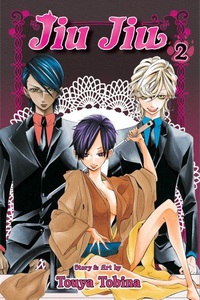Review
by Rebecca Silverman,Jiu Jiu
GN 2 & 3
| Synopsis: |  |
||
Now that Takamichi has accepted Night and Snow as not just jiu jiu but as companions as well, the stage is set for them to have more interactions with each other, schoolmates, and other hunters and supernatural creatures. The trio takes a school trip to the beach where they meet a selkie, interacts with a flying pig that turns out to be a young vampire, and later enter into all-out rivalries for Takamichi's affections at a Hunter gathering. Are Night and Snow human enough to vie for her heart? |
|||
| Review: | |||
Jiu Jiu has made some significant improvements since its first volume. First and foremost is that Takamichi, while still not the world's most charming heroine, has also moved away from being a terribly unlikeable one, and both volumes two and three take pains to show her in a more flattering light. Night also gets a decent amount of character development in volume three, showing him as more than the puppyish pet that Snow still comes off as and helping to add some tension to the storyline. Add in a large amount of (mostly male) new characters, and Touya Tobina seems to have gotten things somewhat on track. Volume two is the lighter of the two volumes while also being the weaker. Tobina tells us that the theme of this volume is “fun,” and she goes to great lengths to establish that. This book takes Takamichi, Snow, and Night to the seaside with their classmates and introduces Meru, a vampire on his adulthood quest whose alternate form appears to be a winged pig-bat. We also meet Lily, a lonely selkie who has been guarding a beach house for her deceased mistress, and between the two of them and Snow and Night, Jiu Jiu seems to be turning into an all-out supernatural reverse harem story. Tobina isn't quite skilled enough to play this for the laughs she wants, and really Meru's pig-bat form is the funniest thing here, but the effort is noticeable and a decided step up from the action of the previous volume. The third book continues this upward trajectory as it spends more time elucidating the relationship Takamichi had with her deceased twin brother Takayuki, as well has her life-long interactions with the other Hunters. The main plot of volume three is a Hunter gathering at which Takamichi must be present as the heir to her clan. She has no desire to be there or to interact with either her former or current fiances, both of whom will be in attendance and add to her growing harem. It is at this point that Night and Snow really assert themselves as men rather than dogs (it began with volume two's collar incident) and we begin to see them as two separate characters rather than “the dark smart one” and “the goofy white one.” Night gets the most out of this storyline, which looks to carry over into the next volume, but what really makes this book interesting are the flashbacks about Takayuki. These do more for the series than anything else thus far, setting up Takamichi as a sympathetic character and giving the story a believable world to take place in, something neither volumes one nor two managed to do. There are still some uncomfortable moments that remind us that Takamichi raised Snow and Night, making the possibility of a romantic pairing (or threesome) a little unsettling, particularly if you see parallels between how she interacts with them and her past with her twin brother. However, since it looks like Tobina has plans to make this a full-out reverse harem, that may become a non-issue. Regretfully Tobina's art is still all over the place. Elongated to the point of bizarreness with ludicrously skinny limbs that bend and move in unnatural ways, the characters themselves are strange looking in several different ways at once. Pages and panels are both crowded, and on occasion one finds oneself flipping back a page with the distinct feeling of having missed something, like a whole page. This is seldom the case; the art and dialogue simply do not flow well. The English adaptation reads naturally – although “your” is used instead of “you're” in volume two – so it feels like the fault must lie with the original. Yes, Jiu Jiu has made some significant improvements since volume one, and looks to be on the path to getting better as it goes on, but it is still far from a polished, engaging series. Awkward art, confusing scene changes, and crowded pages make it difficult to remain immersed in the story, and that story doesn't really even become immersive until volume three. Tobina is clearly trying her hardest to craft and entertaining supernatural tale, but so far it just isn't quite cutting it. |
| Grade: | |||
|
Overall : C+
Story : C+
Art : C-
+ Volume three is significantly better than the previous two, flashbacks about Takayuki help to establish Takamichi's character and past. Takamichi is somewhat more sympathetic. |
|||
| Production Info: | ||
|
Full encyclopedia details about Release information about |
||